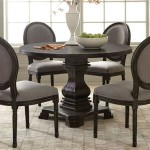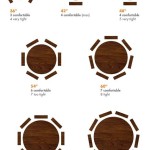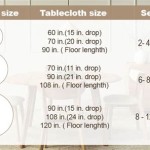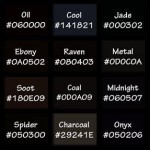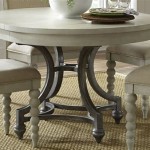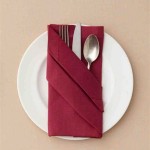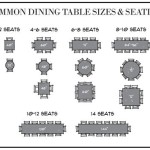What Size Tablecloth for a 72-Inch Round Table
Determining the appropriate tablecloth size for a 72-inch round table is a crucial consideration for both aesthetic appeal and functional practicality. The tablecloth not only enhances the table's appearance but also provides protection against spills and scratches. Selecting the correct size ensures a balanced drape and prevents the tablecloth from being either too short, which looks unfinished, or too long, which can be a tripping hazard or appear sloppy. Considerations include the desired drop length, the occasion, and the overall style being sought.
A 72-inch round table is often used for dining in various settings, from formal restaurants to casual home environments. The size can comfortably accommodate between 8-10 people depending on the chair size and spacing. Therefore, choosing the right tablecloth impacts the dining experience as much as the visual appeal.
Understanding Tablecloth Drop
The term "drop" refers to the length of the tablecloth that hangs over the edge of the table. This is a critical factor in determining the overall size needed. Different drop lengths create different effects, each suited to different occasions and aesthetic preferences.
A standard drop length for dining is typically between 8 and 12 inches. This allows for a sufficient overhang to protect the table without being excessively long. For a 72-inch round table, this translates to a tablecloth ranging from 88 inches to 96 inches in diameter. To calculate this, one simply adds twice the desired drop length to the table's diameter (72 inches + 2 x drop length). For example, for a 10-inch drop, the calculation would be 72 inches + (2 x 10 inches) = 92 inches.
For more formal events, a longer drop is often preferred. A drop of 15 inches or more can create a more elegant and sophisticated look. For a full drop, where the tablecloth reaches the floor, the drop length would be half the table's height (approximately 29-30 inches). However, floor-length tablecloths are more common for display tables or events where a dramatic presentation is desired. They can be impractical for regular dining, especially with frequent foot traffic around the table.
When selecting a drop length, consider the following: the type of event, the formality of the occasion, and the height of the chairs being used. A longer drop may not be suitable if the chairs are too close to the table, as it could interfere with guests' legroom. Similarly, a shorter drop may be more appropriate for casual settings or when using a table overlay.
Calculating the Ideal Tablecloth Size
Calculating the exact tablecloth size involves a straightforward formula. As mentioned, one must add twice the desired drop length to the table's diameter. However, there are other considerations to keep in mind, such as fabric shrinkage and layering.
Firstly, measure the table's diameter accurately. It is crucial to measure across the widest part of the table, ensuring the tape measure passes through the center. If the table has any decorative elements around the edge, take these into account when measuring. An inaccurate measurement will lead to selecting the wrong tablecloth size.
Next, decide on the desired drop length. Visualize how the tablecloth will look with different drop lengths to determine the most aesthetically pleasing option. Consider the overall décor of the room and the type of event being hosted. For a casual brunch, a shorter drop might be suitable, while a formal dinner party may warrant a longer drop.
Finally, consider the fabric of the tablecloth. Some fabrics, particularly natural fibers like cotton and linen, are prone to shrinkage after washing. It is advisable to add a few extra inches to the calculated size to account for potential shrinkage. Check the manufacturer's instructions for any specific recommendations regarding shrinkage allowance.
Layering tablecloths is a popular way to add depth and visual interest to a table setting. If using an overlay, the bottom tablecloth should have a longer drop than the top tablecloth. The overlay typically has a shorter drop, often around 12-18 inches, to showcase the larger tablecloth underneath. To calculate the appropriate size for the overlay, subtract the difference in drop lengths from the calculated size of the bottom tablecloth.
For instance, if the bottom tablecloth has a 15-inch drop (requiring a 102-inch round tablecloth), and the overlay is intended to have a 12-inch drop (requiring a 96-inch round tablecloth), the overlay size would be 96 inches. This creates a visually appealing layered effect without excessive fabric bunching or dragging on the floor.
Material Considerations and Aesthetic Impact
The material of the tablecloth significantly influences its appearance and functionality. Different fabrics offer varying levels of durability, stain resistance, and drape. Choosing the right material is essential for achieving the desired aesthetic and ensuring the tablecloth is suitable for its intended purpose.
Polyester is a popular choice for tablecloths due to its durability, stain resistance, and affordability. It is relatively easy to care for and holds its shape well, making it ideal for frequent use. Polyester tablecloths are available in a wide range of colors and patterns, offering versatility for various occasions.
Cotton tablecloths offer a soft, natural look and feel. They are breathable and absorbent, making them a comfortable option for dining. However, cotton is more prone to wrinkles and stains than polyester. Regular ironing is often required to maintain a crisp appearance. Cotton tablecloths are best suited for casual or semi-formal settings.
Linen tablecloths exude elegance and sophistication. They have a luxurious texture and drape beautifully. However, linen is the most expensive option and requires careful handling. It is prone to wrinkles and stains and may require professional cleaning. Linen tablecloths are typically reserved for formal occasions or high-end dining establishments.
In addition to the material, the color and pattern of the tablecloth can also impact the overall aesthetic. Light colors, such as white or ivory, create a clean and timeless look. They are versatile and can be easily paired with different décor styles. Dark colors, such as navy blue or burgundy, add depth and richness to the table setting. They are often used for formal events or to create a more intimate atmosphere.
Patterned tablecloths can add visual interest and personality to the table. Geometric patterns, floral designs, and stripes are popular choices. When selecting a patterned tablecloth, consider the overall décor of the room and the other elements of the table setting. Avoid patterns that clash or overwhelm the space. A subtle pattern can enhance the table without drawing too much attention.
The choice of tablecloth material and design is a crucial element in creating the desired atmosphere for any occasion. By carefully considering the available options and selecting a tablecloth that complements the overall décor, one can enhance the dining experience and create a visually appealing setting.

100 What Size Tablecloth For 72 Inch Round Table Cool Apartment Furniture Check More At Http Livelyli Sizes Cloth

Linen Size Guide

How To Figure Out Your Tablecloth Sizes Whole Wedding Chair Covers

Juvale 12 Pack Black Plastic Tablecloth 84 Inch Round Disposable Table Cover Fits Up To 72 Tables Themed Party Supplies Com

72 Round Plastic Table Riverside Ca Party Als

Solid Color Polyester Table Linens 120 Round Royal Settings Llc

108 In Round Polyester Tablecloth 30 Colors Linentablecloth

Your Chair Covers 132 Inch Round Satin Tablecloth White Com

72 Round Folding Table Plastic For Banquets More

2024 What Size Tablecloth Do I Need Reventals Event Als
Related Posts

